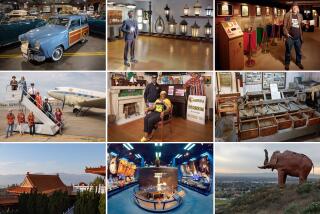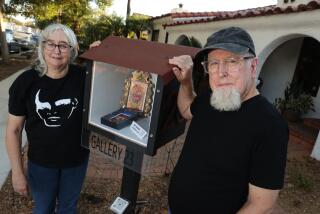Little Museum Gets Big Boost From Patrons
- Share via
In the beginning was the collection.
Back in the 1920s, the still-youthful city of Oxnard began acquiring art. Decades later, it was looking for a place to exhibit it.
Enter the impressive neoclassical structure on C Street, built in 1906 by Andrew Carnegie as part of a nationwide series of libraries.
By 1980, the structure had moved on from its original function, becoming a Chamber of Commerce headquarters and even, in the early ‘70s, a facade for the “Dan August” TV show. But because of structural problems and the need for earthquake retrofitting, the building was in danger of being razed.
Then the city realized that it was an art museum waiting to happen.
Today, the Carnegie Art Museum, so designated by City Council resolution in 1984, is a well-established small museum, the only dedicated art museum in the county.
It offers several exhibitions a year and boasts a growing permanent collection -- with about 1,000 artworks -- and a strong educational agenda.
It also boasts generous patrons, as evidenced by the current show in the main gallery. “A Legacy of Giving” is a selection of past, present and promised gifts to the Carnegie permanent collection.
As curator and director Suzanne Bellah walked a visitor through the show recently, she noted that the Carnegie’s combination of modest size and solid reputation has spurred generosity.
“A lot of donors are getting savvy about what impact their donation will have on an institution,” she said. “If it’s a huge institution, maybe it might actually be redundant. Sometimes, I hear that they’d like to give something that would be out more often or that would really make a difference.”
The collection began in 1924, when the Art Club of Oxnard scraped together enough money to buy California landscape painter Katherine Leighton’s “Desert Bloom.”
“Oxnard is an interesting place,” Bellah said. “It has always had this commitment to art. Nothing was out here except lima bean fields, and they were buying art from Laguna painters. One way or another, it has always found a way to continue.”
While many arts institutions have struggled in recent years, the Carnegie is on a gradual upward path.
The historic building is in the midst of a city-financed renovation, including a fresh coat of paint and waterproofing. Future goals include a humidity and climate-control system, Bellah said, which would “affect the types of exhibitions we can borrow. It will allow us to better preserve the collection that we’re growing, for posterity.”
For a small museum, the Carnegie stays lively. Between its downstairs galleries, including one usually devoted to county artists, and the upstairs, the museum has a fair amount of exhibition space. Most often, two or three shows are on view.
Currently upstairs is “A Tour of California: Landscape Paintings by Frank Lennartz,” the Oak Park-based winner of the museum’s annual competition for lesser-known regional artists. Local artist Cheryl Ann Thomas is showing her ceramic sculpture in the smaller regional gallery.
Along with a leaning toward California art, the Carnegie has been a likely place to find contemporary work. Memorable exhibitions in recent years have included shows by Ojai-based painter Michael Dvortcsak, a traveling show of modernist prints, and a show of work by the late Joyce Trieman.
The Carnegie’s collection was given a boost with a sizable donation of contemporary art from collectors Peter and Eileen Norton. That, in turn, has inspired other contemporary acquisitions, such as new pieces by Charles Arnoldi. Latino art has also been a focus. Frank Romero has been featured several times, and an upcoming show will present East L.A. artist Gronk.
Last year, the museum enjoyed a 39% increase in visitors with a total of 37,000.
Along with city support, it has received help through fund-raising efforts of a group of museum volunteers called Cornerstones, and has obtained grants from companies such as Procter & Gamble, Bank of America and Midstate Bank.
“As our funding resources grow, we’re able to put on higher- and higher-caliber exhibitions. The better the art, the more you can teach from it,” Bellah said.
At this point, Bellah said, the Carnegie has a “wonderful need” to expand its existing space or spread out into a secondary structure. With the growth of the collection and the staff, the building is stretched to its limits.
While recognizing that the current economic climate may not be friendly, Bellah said that the growing pains amount to “a wonderful problem to have. That shows, to me, that there’s both an interest and a need for expansion.”
More to Read
The biggest entertainment stories
Get our big stories about Hollywood, film, television, music, arts, culture and more right in your inbox as soon as they publish.
You may occasionally receive promotional content from the Los Angeles Times.










